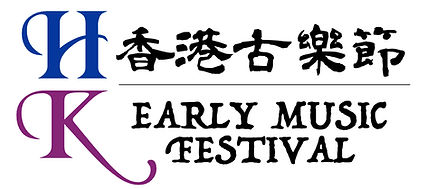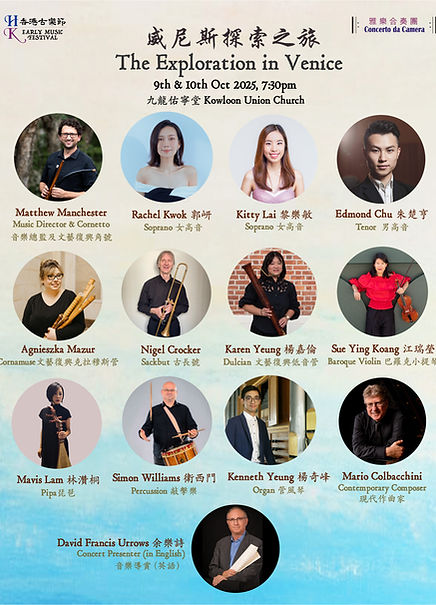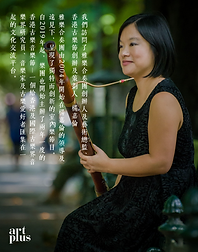
Latest News 最新動向

The 4th Hong Kong Early Music Festival 2025
第四屆香港古樂節
The Story of Two Cities
From Venice to Hamburg
雙城故事
從威尼斯到漢堡

門票現於 art-mate.net 發售
Concert tickets available at art-mate.net
票價 Ticket price
正價 Standard : $290
特惠* Concessions*: $190
*特惠門票適用於六歲或以上全日制學生、 60歲或以上長者及殘疾人士。
*Concession tickets are available to full-time students ages 6 or above senior citizens ages 60 or above, and persons with disabilities.
場地
九龍佑寧堂
佐敦道4號(佐敦地鐵站B2 出口)
Venue
Kowloon Union Church
No.4 Jordan Road, Kowloon (MTR Jordan Station Exit B2)
音樂會全長:約1小時50分鐘,包括10分鐘之中場休息。
Concert Duration : Approx. 1 hour 50 min with 10 min intermission.
查詢 Enquiry
WhatsApp : 97313388
電郵 Email : concertodacamerahk@gmail.com
網址 Website: www.concertodacamera.org
香港藝術發展局支持藝術表達自由,本計劃內容並不反映本局意見。
The Hong Kong Arts Development Council supports freedom of artistic expression. The views and opinions expressed in this project do not represent the stand of the Council.
如遇特殊情況,主辦機構保留更改節目及表演者的權利。
The Presenter reserves the rights to change any program and substitute artists should unavoidable circumstances make it necessary.
Trailer 預告
Click in to read the South China Morning Post interview released on 30 Sep 2025
Click in to read the RTHK RADIO 4 interview
broadcast on the 3rd October 2025.
Click to read the article from ArtMap


《威尼斯探索之旅》 The Exploration in Venice
Performing works by
Gabrieli, de Rore, Marini, Castello, Ziani, Turini, Fontana, Weckmann & Schütz
世界首演 Mario Colbacchini全新作品
World première of a new work by Mario Colbacchini
音樂會 Concert
9th & 10th Oct 2025 at 7:30pm
Matthew Manchester
Music Director & Cornetto
音樂總監及文藝復興角號
Rachel Kwok 郭岍
Soprano 女高音
Kitty Lai 黎樂敏
Soprano 女高音
Edmond Chu 朱楚亨
Tenor 男高音
Agnieszka Mazur | Cornamuse
文藝復興克拉穆斯管
Nigel Crocker
Sackbut 古長號
Karen Yeung 楊嘉倫
Dulcian 文藝復興低音管
Sue Ying Koang 江瑞瑩
Baroque Violin 巴羅克小提琴
Mavis Lam 林灒桐
Pipa 琵琶
Simon Williams 衛西門
Percussion 敲擊樂
Kenneth Yeung 楊奇峰
Organ 管風琴
David Francis Urrows 余樂詩
Concert Presenter (in English)
音樂導賞 (英語)
The Story of Two Cities
From Venice to Hamburg
Both Venice and Hamburg were once major commercial ports in European history. International trade brought them immense wealth, while the convergence of peoples and cultures fostered a fertile ground for artistic flourishing.
Since the fifteenth century, Venice’s churches, merchants, and rulers have actively patronised music. As a thriving centre of trade between East and West, the city absorbed diverse influences from North Africa, the Middle East, and beyond, enriching its musical landscape.
Drawn by its vibrant musical scene, many of the most renowned early Baroque composers—including Marini and Gabrieli —chose to live and work in Venice. Musicians from across Europe also travelled to the city to study and work; among them was Schütz, considered the greatest German composer before Bach. The works of these composers deeply shaped the evolution of Western classical music, and later German Baroque masters such as Telemann and Händel absorbed the Italianate style into their own compositions.
Seventeenth-century Europe was a time of profound religious, political, and economic transformation. With the opening of the Atlantic trade routes, Hamburg rose to become one of the most important port cities in northern Europe—and simultaneously a vibrant cultural hub. It became the heart of the North German organ school and proudly hosted Germany’s first public opera house.
For this year’s Hong Kong Early Music Festival, Concerto da Camera has chosen Venice and Hamburg as the focal points of our musical journey. We have curated a diverse selection of vocal and instrumental works to showcase the rich musical cultures of these two iconic cities.
The Festival comprises four concerts. The first two, The Exploration in Venice, spotlight early Baroque music from Venice alongside works by German composers inspired by the Venetian style. The final two, The Golden Era in Hamburg, turn to Hamburg, presenting music by composers shaped by the city’s vibrant artistic energy. Between the pieces, there will also be English narration that illuminates these lesser-known hidden gems from multiple perspectives.
The concert will also unveil two freshly commissioned works by Italian composer Mario Colbacchini and local composer Lee Wai Shan, each evoking the spirit of Venice and Hamburg in a vivid musical dialogue.
Since its founding, Concerto da Camera has been dedicated to promoting early music to the public, while fostering exchange and collaboration between local and international artists. We are steadfast in our commitment to performing on period instruments and employing historical vocal techniques, bringing new inspiration from the past to life, and offering audiences a truly unique musical experience.

《漢堡的黃金時代》The Golden Era of Hamburg
Performing works by
Telemann, Mattheson, Handel & Graupner
世界首演李慧珊全新作品
此作品於 2025 年由 雅樂合奏團有限公司委約,
費用由香港作曲家及作詞家協會轄下的「CASH 音樂基金」贊助
World première a new work by Lee Wai Shan
This new work is commissioned by Concerto da Camera Limited
in 2025 with sponsorship from CASH Music Fund
音樂會 Concert
13th & 14th Oct 2025 at 7:30pm
Matthew Manchester
Music Director & Baroque trumpet
音樂總監及巴羅克小號
Kitty Lai 黎樂敏
Soprano 女高音
David Tong 唐書堯
Recorder 木笛
Joyce Cho 曹慧芷
Baroque Oboe 巴羅克雙簧管
Agnieszka Mazur | Baroque Oboe & Recorder
巴羅克雙簧管及木笛
Karen Yeung 楊嘉倫
Baroque Bassoon 巴羅克巴松管
Sue Ying Koang 江瑞瑩
Baroque Violin 巴羅克小提琴
Kate Moran
Baroque Violin 巴羅克小提琴
Hyunjung Choi 崔賢貞
Baroque Viola 巴羅克中提琴
Shelagh Heath 洪嘉儀
Baroque Cello 巴羅克大提琴
Simon Williams 衛西門
Percussion 敲擊樂
Kenneth Yeung 楊奇峰
Harpsichord 古鍵琴
Matthias Kaufmann 高明德
Concert Presenter (in English)
音樂導賞 (英語)
雙城故事
從威尼斯到漢堡
威尼斯及漢堡都曾是歐洲歷史上的主要商業港口,國際貿易為這兩座城市帶來了財富,人與文化的交流匯聚積累出深厚的藝術土壤。
自十五世紀以來,威尼斯的教會、商賈及統治者對音樂藝術提供了大量贊助,而作為東西方貿易樞紐亦令威尼斯在文化藝術方面不斷受到來自地中海彼岸的鄂圖曼帝國、中東,甚至遠東地區的風格影響。不少最著名的早期巴羅克作曲家,例如馬利尼、加布里埃利等,都選擇在威尼斯定居工作;許多其他歐洲國家的音樂家亦慕名前往學習及工作,當中就包括被譽為在巴赫之前最偉大的德國作曲家舒茲。他們的作品對西方古典音樂的發展影響深遠,後來的泰利文、韓德爾等德國巴羅克代表人物均吸收了豐富的意大利元素,將之融入作品當中。
十七世紀的歐洲無論在宗教、政治或經濟方面都經歷著巨大的變遷。大西洋貿易航道的開發令漢堡發展成當時北歐最大的港口城市之一,並同時成為一大文化重鎮。它既是德國北方管風琴樂派的中心,亦是德國第一座公共(非皇室)歌劇院的所在地。
在本屆香港古樂節,雅樂合奏團選擇了這兩座城市作為我們的音樂旅程的焦點。我們挑選了一系列聲樂及器樂作品,為觀眾呈現兩地的音樂文化面貌。
古樂節包含四場音樂會。首兩場音樂會《威尼斯探索之旅》聚焦於來自威尼斯的早期巴羅克音樂,以及受威尼斯風格影響的德國作曲家作品。後兩場音樂會《漢堡的黃金時代》則以漢堡為中心,演出多位深受這城市的藝術力量所薰陶的作曲家之作品。我們在樂曲之間安排了旁述簡介,從不同角度介紹這些較不為人熟識的滄海遺珠。
此外,音樂會中將首演兩首全新委約作品 — 一首由意大利作曲家 Mario Colbacchini 譜寫,取材其成長之地威尼斯;另一首則由本地作曲家李慧珊以漢堡為靈感而創作。樂曲把兩地風情化為旋律,編織出一場橫越地域與時光的音樂對話。
雅樂合奏團自成立以來,一直致力於向公眾推廣古樂文化,同時推動本港及海外藝術家的交流合作。我們堅持以仿古樂器及復古演唱法演繹早期音樂的作品,從歷史中發掘新靈感,為觀眾帶來獨一無二的音樂體驗。












